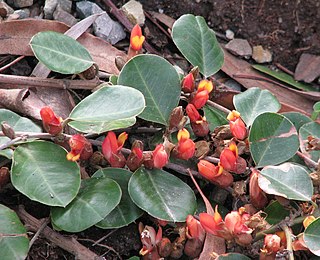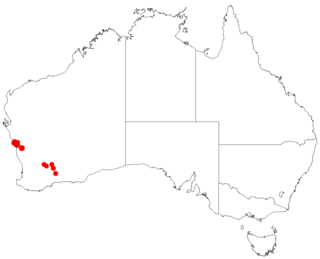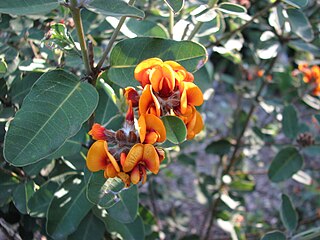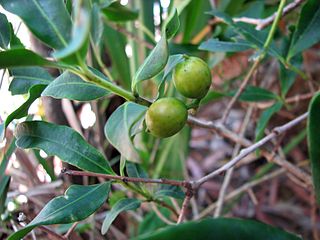
Cullen is a genus of legumes native to tropical, subtropical and arid regions of Africa, Asia and Australia. Despite the origin implied in the name of the constituent species Cullen americanum, legumes of this genus are not native to the Americas.

Actinodium cunninghamii, commonly known as swamp daisy or Albany daisy, is the only formally described species in the genus of flowering plants in the family Myrtaceae, Actinodium and is endemic to Western Australia.

Grevillea miniata, commonly known as sandstone grevillea, is a species of flowering plant in the family Proteaceae and is endemic to north-western Australia. It is a spreading to erect shrub or small tree with more or less oblong leaves and bright yellow to orange and bright red flowers with a yellow style.

Gastrolobium minus, also known as broad-leaved brachysema, is a prostrate shrub which is endemic to the south-west of Western Australia. It is a member of the family Fabaceae and of the genus Gastrolobium, which contains many toxic species, however the toxicity of this species is unknown.

The flora of Western Australia comprises 10,842 published native vascular plant species and a further 1,030 unpublished species. They occur within 1,543 genera from 211 families; there are also 1,335 naturalised alien or invasive plant species more commonly known as weeds. There are an estimated 150,000 cryptogam species or nonvascular plants which include lichens, and fungi although only 1,786 species have been published, with 948 algae and 672 lichen the majority.
Melaleuca penicula is a plant in the myrtle family, Myrtaceae and is endemic to the south of Western Australia. It is a rare species only known from the Fitzgerald River National Park and resembles Melaleuca eximia with its spikes of red flowers but its leaves and stamen bundles are different.

Styphelia marginata, commonly known as thick-margined leucopogon, is a species of flowering plant in the heath family Ericaceae and is endemic to the south-west of Western Australia. It is a dwarf shrub with lance-shaped leaves and white, tube-shaped flowers.
Muelleria is a peer-reviewed scientific journal on botany published by the Royal Botanic Gardens Melbourne. It focuses on topics relating to plants, algae, and fungi in the southern hemisphere and Australia in particular. The journal was named in honour of Victorian Government botanist Ferdinand von Mueller. Muelleria commenced publication in 1955 with funding from the Maud Gibson Trust. The trust was initiated in 1945 following the donation of £20,000 by Maud Gibson, a daughter of William Gibson, founder of the Foy & Gibson department store chain.

Gastrolobium coriaceum is a shrub species in the family Fabaceae. It is endemic to the south west of Western Australia.

Alyxia spicata, commonly known as chain fruit, is a sprawling shrub or vine in the family Apocynaceae. It is native to New Guinea and the Australian tropics.

Acacia eremophila is a shrub of the genus Acacia and the subgenus Plurinerves that is native to Western Australia.

Grevillea erythroclada, commonly called needle-leaf grevillea, is a species of flowering plant in the family Proteaceae and is endemic to northern Australia. It is a shrub or small tree with divided leaves, the ultimate lobes linear to more or less cylindrical, and clusters of cream-coloured to pale yellow flowers.
Actinoschoenus arthrostyloides, commonly known as hairy actinoschoenus, is flowering plant in the sedge family, Cyperaceae, that is native to Western Australia throughout parts of the Kimberley region.

Pityrodia obliqua is a flowering plant in the mint family Lamiaceae and is endemic to the Kimberley region of Western Australia. It is an erect shrub with hairy stems, wrinkled, egg-shaped leaves and pink, bell-like flowers with purple streaks inside.

Boronia pauciflora is a plant in the citrus family Rutaceae and is endemic to the Kimberley region of Western Australia. It is an erect shrub usually with simple leaves and white to pink, four-petalled flowers.

Goodenia heppleana is a species of flowering plant in the family Goodeniaceae and is endemic to northern Australia. It is an erect or prostrate herb with lance-shaped leaves at the base of the plant and racemes of yellow flowers.
Cryptandra intratropica is a flowering plant in the family Rhamnaceae and is endemic to the Kimberley region of Western Australia. It is a slender, erect or spreading shrub with wedge-shaped to oblong or egg-shaped leaves and clusters of yellow to cream-coloured, tube-shaped flowers arranged in head-like clusters.
Senna cladophylla is a species of flowering plant in the family Fabaceae and native to Western Australia and the Northern Territory. It is a perennial herb or undershrub with pinnate leaves with two or three pairs of broadly elliptic leaflets, and yellow flowers arranged in pairs, with ten fertile stamens in each flower.

Cullen pallidum, the woolly scurf-pea, is a species of Cullen, a short-lived perennial herb, considered native and found in all states of mainland Australia. It is considered rare in Victoria and common in all other states. Its common names include: woolly scurf-pea, woolly psoralea, Bullamon lucerne, and white scurf-pea. Found primarily in habitats characterized by moving sand dunes, this species often has lower stems partially buried beneath the sand.

Cullen tenax, commonly known as emu foot, is a herbaceous, perennial shrub. Often found in forest or on heavy soils in medium to low rainfall areas in south eastern Australia.













